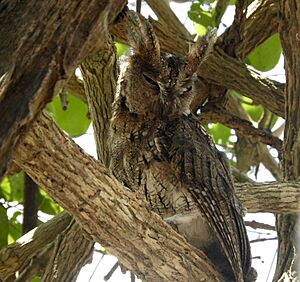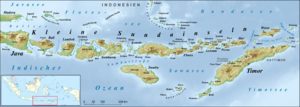Wallace's scops owl facts for kids
Quick facts for kids Wallace's scops owl |
|
|---|---|
 |
|
| Conservation status | |
| Scientific classification | |
| Genus: |
Otus
|
| Species: |
silvicola
|
 |
|
The Wallace's scops owl (Otus silvicola) is a special type of owl. It lives only on the islands of Sumbawa and Flores in Indonesia. These islands are part of the Lesser Sundas. This owl is not rare in its home. It is also called the Lesser Sunda scops owl. It got its name from Alfred Russel Wallace. He was a British naturalist and explorer.
This owl is active only at night. It has mostly brown feathers. It also has long ear tufts and bright yellow eyes. Its chest has strong stripes. An adult owl is about 23 to 27 centimeters (9 to 101/2 inches) long. It weighs about 210 grams (71/2 ounces). You can tell it apart by its call. It sounds like a sword swishing!
The IUCN says this owl is "Least Concern." This means it is not in danger right now. This was decided in 2016. The number of these owls seems to be staying steady.
We still need to learn more about this bird. Scientists want to know more about its habits, how it has babies, and what it eats.
Contents
About the Wallace's Scops Owl
The adult Wallace's scops owl is about 23 to 27 centimeters (9 to 101/2 inches) long. It weighs around 210 grams (71/2 ounces). Its wings can spread out very wide.
This small bird looks like a typical owl. It has a round face and long ear tufts. Its eyes are a bright yellow color. Its feathers are brown. Its face is light-colored. It has a gray beak. Its chest and sides have dark stripes. The top part of its body is a lighter gray-brown.
Its flight feathers are a light tan color. They have dark brown stripes. Its tail is brown with light tan stripes. The owl's legs and some of its toes have feathers. Young owls are usually lighter in color. Their feathers are also fluffier.
Owl Family Tree
In the 1800s, owls were put into two main groups. One group is called the Strigidae. This is the "true owl" family. The Wallace's scops owl belongs to this group. True owls look like what most people imagine an owl to be. They have big eyes and flat faces. They are active at night. They can fly very quietly.
The Wallace's scops owl lives in the same areas as the Flores scops owl. The Flores scops owl is much smaller.
Where Wallace's Scops Owls Live
This owl lives only on the islands of Flores and Sumbawa in Indonesia. It can be found in many different places. These include forests and farm areas. You might also see it in backyards or bamboo patches. It often sits at the very top of tall trees. It can also hide well, making it hard to spot.
Wallace's scops owls are common at certain heights. They live between 350 and 1,600 meters (0.2 to 1 mile) above sea level.
Owl Behavior
The Wallace's scops owl is a night owl. This means it is active after the sun goes down. It is also thought to stay in one place. It does not move far from its home on the Flores and Sumbawa islands.
Owl Calls and Sounds
This owl makes three main types of calls:
- One call is a series of "hwomph" sounds. It can repeat this 9 to 18 times. This call might be how the owl marks its territory. It sounds like a sword swishing.
- Another call is a series of gruff "rrow" notes. These are repeated about once a second. They are at the same sound level as the first call.
- The third call is a whistle. It has different tones.
What Wallace's Scops Owls Eat
Scientists believe this owl mainly eats insects. More studies are needed to know exactly what it eats.
Reproduction and Life Cycle
We do not know much about how this owl has babies. It has been noted that male owls have larger reproductive organs in December. This might mean they are ready to mate around that time.


